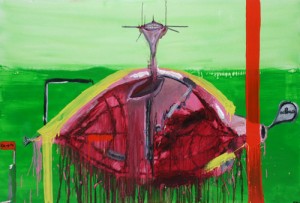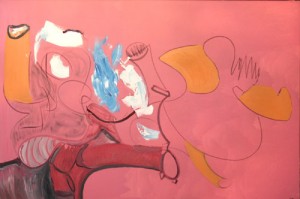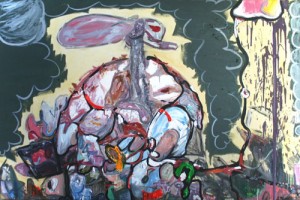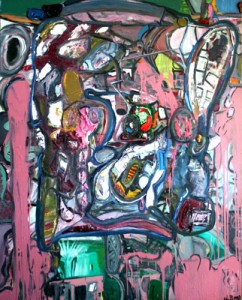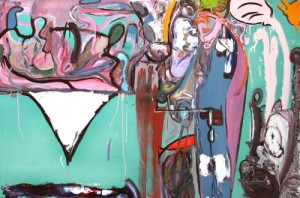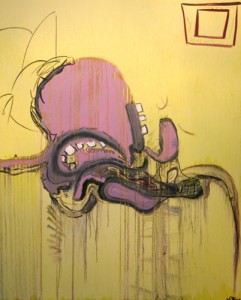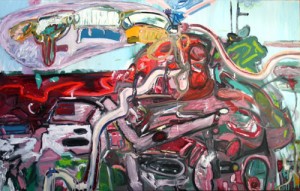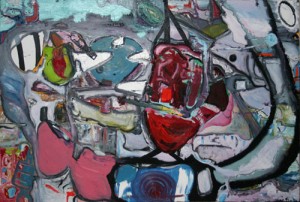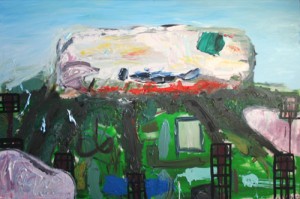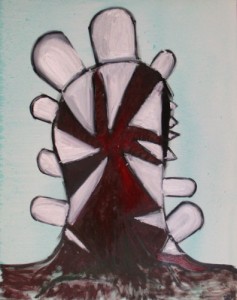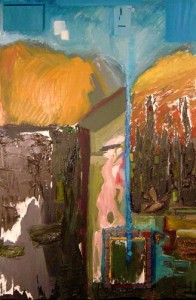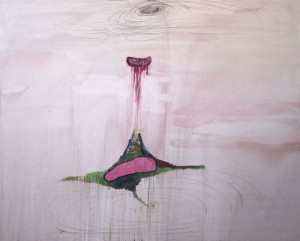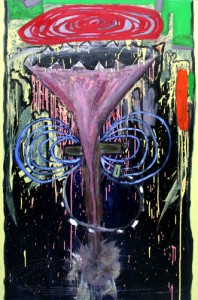no images were found
Author Archives: admin
An Anti-Aesthetic History of Idolatry
An Anti-Aesthetic History of Idolatry
(Literature by Maxwell H. Pines and Paintings by Ian E. Pines)
Our project expresses a philosophical interpretation of changes in attitudes prompted by social evolution and scientific advancement in our contemporary day. The elements of our project are 10 paintings, 10 corresponding aphoristic-essays and one summary-disquisition.
Our basis is a Nietzschean genealogy, a naturalistic origin story given to account for the prevalence of metaphysical myth. The idols of our civilization, God, ethics and the beautiful are hypostatized in reaction to consciousness of a disparity between what is and what ought to have been. A psychological, historical, story-like account in explanation of what were once our most secure and sustaining truths resonates in our contemporary ears already attuned to the changes entailed by advances in science and shifts in social structure. Genealogy does not disprove the existence or validity of idols, rather it makes them look ridiculous. With our anti-aesthetic style the postulation of idols is presented as a conspicuous and ugly aberration from rational thought. We show how the myths have devalued the world and how they themselves have been revealed as the figments of desperate faith and timid recidivism. The fear is that should the idols depart our world, we are left with colorless dirt resulting in the character of today’s spirit: feckless irony or alternatively, undignified regression. Our project is an honest and creative expression of and for our situation: we work to disparage the tired idol of beauty and free us from her grip, making space for the future authentic creation. Our modus operandi is the anti-aesthetic, at once a confrontation and a style.
Our myth: an eternal idol. For we cannot know that which will change. What decays cannot be beautiful. What is true cannot die. There must be something good far away from here.
We were in horror of what we saw: flux, life living off life, dirt. Our consciousness of the disparity between desire and satisfaction, what is and what ought to be is a terrible burden. A burden made lighter by faith in the other, extra, true world far away from here. So we believed.
But the myth is no longer tenable. Not disproved but made ridiculous by the advance of human knowledge. Once the continuity between generations and stagnant ideas made a comforting world-view seem eternal. But today physical and moral landscapes metamorphose before our eyes. Technology telescopes change; evolution is axiomatic of modern thought.
The more absurd the idols become, the more precious they seem: have we nothing else? When we placed value in the other world, we devalued this one. We foreswore what we could touch and see. And that, the depreciated matter on which we live, who we are, is all that is left should the idols crumble. It is a dreadful task to unchain ourselves from the sun. The spirit of gravity beckons us back to our warm cradle of eternal canons of knowledge to be put to sleep by the opiate of faith.
But for one who can affirm what he sees, our unique situation is the greatest of opportunities. The clearing away of the idols would leave a space where one can express, invent, and celebrate. The actualization of this possibility is the aim of the anti-aesthetic creation. Lest we fall prey to the inhumanity of nihilism and depravity, the idols of the metaphysic and the ethical must not be spat upon. But turn about devaluation is fair play against the idol of beauty. Tired ideal, Goddess ripe with decay stands in the way of the authentic expression of our day.
Memeology: Natural History, Crisis, and Renewal in Eight Parts
Memeology: Natural History, Crisis, and Renewal in Eight Parts
8 new paintings by Ian E Pines
interpretative essays by Maxwell H Pines
Memes
A meme is a phenomenological unit, an atom of experience. The compositional analysis of an experience bottoms out in memes: flashes of color, bursts of sounds, pinpricks of touch, infinitesimals of sensation. By definition, memes are of a transient and dependent existence.
Blips on a screen.
Memes interact in accord with brute laws of attraction and repulsion: likeness and difference; harmony and dissonance; intensification and nullification. From these constraints, memes and meme-logic, the experience can be reconstructed.
In order to understand a meme, stay on the surface. Memes are only thick enough to appear on the screen. And that’s not very deep.
Investigation of their laws of interaction yields no causal nexus, no purposive direction. The laws are such that y-memes appear after x-memes; constant conjunction and a feeling of anticipation: X’s and Y’s, X’s and Y’s, X’s and Y’s. Call it meme-logic. How about “causation”? Only as you would say the shadow of the hammer causes the shadow of the nail to go downwards.
Meme-logic is sufficient to determine that there will be structured, internally complex meme-compounds: harmonized patterns of memes, lattices of memes. Agglomeration and bulk give them momentum and significance: meme-compounds exist long enough to be distinguished by a subject as individual objects. They stand out from the flashing hailstorm of memes, flashing and diminishing.
Meme-evolution
The thicker the boundary separating a meme-compound from the outside, the longer it builds its momentum and intensity. Incorporation, assimilation, agglomeration. Within the meme-compound arises a division of labor, a unity and purpose. Now there is a division between the chaotic, senseless succession of memes and a sanctuary of relative order within the meme-compound.
Calculations of meme-logic become fantastically complex, but no one has to do the book keeping. At a certain point of complexity we lose track of the determinations of meme logic: the spark of life.
A kingdom within a kingdom? Behold the meme-creature.
The emerging meme-creature is a ferocious automaton animated by mechanical, purposive behavior and a single minded resolve to execute its program.
And now an ecology, a plurality of niches and diverse responses: paranoia, aggression, parasitism. Violence and grim resignation to its lot drives a meme-creature to retreat within its boundary; its sanctuary of order and respite—a garden of manicured bushes and clockwork fountains.
Meme-creature
Look: can you see its mind? the seat of consciousness? the will?
What is a meme-creature, what animates this purposive unity?
-Is it a finite system deducible from the constraints of the memes themselves: a difference of degree and not of kind, continuous with the outside. More meme-logic. And thus there is a possible unified science of memes and meme-creatures.
-Or: perhaps there are special spots within the boundaries composed of non-memes that drive the meme-creature*.
-Or better yet: outside the system, compelling and driving inert memes with purpose and intent from beyond the screen†.
There are irresistible conclusions one will draw from an invested point of view. You better believe it.
*The unity is ultimately to dissolve back into the same meme-soup from which it arose.
†Forgot that the surface is as deep as the screen; there, a furiously flashing succession of color and shape.
Idols
Poor, forlorn meme-creatures, subjects of a painful and senseless destiny. Their desire for the eternal, meaning, the unconditioned… they need a sign.
Meme-logic delivers. Meme after meme caked on results in giant meme-compounds; enduring monoliths of sensation.
To a meme-creature this is an object to be appropriated. A meme-creature who longs for respite and validation alters and exalts this IDOL.
Lifted up to eternality, divinity, an idol is: a crutch, a beacon, a conduit to an alternative plain of existence (whoh), an explanation, an explanandum, a telephone.
“were we born here, is this where we return, have you heard the good news?”
Meme-creatures active in their forgetful embrace of their idol become bold or peaceful; evangelical or mystical; conquistadors and clerics. Memes animated by their worship and servility to Idols overcome pain and fear. Remarkable specimens!
Illness
What is a sickness that only appears and worsens as the patient becomes more and more efficient, insulated from an uncaring and potentially damaging exterior? It is a disease latent in meme-creatures who have indulged in the sublime myths of idols, a sickness that emerges as a meme-creature remembers its idol’s design of expediency, ineluctable meme-logic, and the thinness of memes. They are suspicious when they see their own fingerprints on Idols, amazed at the unity of meme-logic, and despondent that despite their best myths, they are still just memes.
The meme-creature’s capacities to reflect, to defend against the hail-storm of memes, to construct ever-greater idols—those same advantages handed to it in meme-evolution have alienated it from its nature continuous with senseless memes. The apparant boundary built by meme-logic and sanctified by custom is falling apart.
Crisis
Idols are the meanings for meme-creatures. For what else is there in their devalued environment, meme-filled bodies? Once a meme-creature has lost confidence in itself, an idol is adopted as the symbol for and object of its purposive behavior.
But given that all things meme reek of meaninglessness, meme-creatures must go wholly outside the backdrop of phenomena. Local idols are forgotten and grow mossy or are banished and take off into outer space. In a desperate attempt at self-signification, the meme-creatures posit the IDOL beyond the world, the object of a most sublime faith.
But idolatry becomes absurd as meme-creatures become cognizant of the psychological explanation of their attraction to idolatry. Idolatry is disproved indirectly; just as we discount the prophet who sees ghosts once we discover the empty vial of acid in his pocket.
A meme not on a canvass is manifestly repugnant; that’s clear enough.
Reunification
A meme-creature who looks the same on the inside as the world outside?
The thick black partition separating a meme-creature’s unified consciousness from the chaotic, meaningless flashing succession of lights and sounds… This boundary is a matter of degree; a pretty significant degree to an insular meme-creature. But sub specie aeternitatis (as all educated meme-creatures now speak) to one who looks at its place in the grand screen of things? Not so impressive. A meme-creature whose thoughts have been elevated in contemplation of idols takes on this objective perspective. It sees how it made its boundary significant and thinks: a line I draw, I can erase.
It recognizes its continuity; it recognizes the boundary as a convention of its own design.
Meme-creatures have devalued the memes through their exaltation of idols. Will this be a happy reunion?
Our Greatest Question Mark
Idols, now divested of meaning, still populate the landscape. Meme-creatures lurch from one end of the grave yard, now snickering, now weeping over these cracked monuments. Nauseous from the continuous cycling through of worldviews: groundless, absurd faith, crippling despair and bitter, bitter irony.
Now what? A meme-creature gazes into the horizon, shameless in the nude:
The X I am.
ground law end beyond… begone!
The feeling of…
spontaneity
Feel: a lifting of the burden to explain and justify. An increase of energy.
Just as meme-creatures were inspired by their idols to become the most amazing phenomena, except now the direction of the energy is yet to be determined.
Memeology and Manifesto
Memeology and Manifesto
(Written by Ian Pines and Edited by Maxwell Pines)
A manifesto is a declaration and justification of a purpose. It should therefore articulate intentions while demonstrating their urgency and legitimacy; it should incorporate elements of both theoretical and practical treatises as it must explain and justify. I will here present the manifesto of my artwork. Art that is not simply a clever idea or a work of eye-catching technical skill, so that it is worth the space it takes up, requires the canvas to be informed by a meaning and for the brushstrokes to be animated by an imperative to act. My theory claims that we are confronted with growing disenfranchisement and apathy in the face of the de-bunking of our comforting myths and religious stories—a consequence of telescopic technological and scientific changes. My practical solution is an honest and passionate expression of our condition in art. My art is an affirmation; an affirmation of what and why, I wish to explain in this manifesto.
This manifesto has elements of allegory, philosophy and art criticism. It is separated into four parts. In Part One, I tell a cosmological creation story: a myth, or, more to the point, the natural history of a parallel universe. Towards the end of Part One there is an interlude where the cosmology is intertwined with Friedrich Nietzsche’s On the Genealogy of Morals. My Memeologyitself is a genealogy of sorts. Its similarity to Genealogy shows the relevance of the story of the memes and the shape of the ideas needed for the overcoming of nihilistic gravity. The interlude then ends and the manifesto returns to the conclusion of Part One. In Part Two, the evolution of my artwork is looked at from its own display of the cosmology described by the preceding part, And then in Part three, the cosmological diagram is demonstrated to be a theme by which we can understand other painters. And finally, Part Four is a short synopsis of what my brother’s and my collaborations could eventually be in the future.
Part One: Memeology
One: The Memes
A meme is the most basic unit of information. These are the atoms, irreducible, primitive. The spectrum of possible sensations, concepts, and ideas is analyzed into these phenomenological dots of varying sizes, shapes, and affinities. That spectrum is built back up as memes combine as per their logical chemistry: {And, Or, Not, If, Then}.
As far as their metaphysic: their “from whence and why;” memes lack the expressive capacity to represent possible answers and even to formulate the question. For a meme is information, truth, semantics. Therefore to represent a meaning that stands beyond memes that could explain their origin or provide validation is impossible. Explanation, if it existed, would tell why things are so and so; justification would give it sense and meaning. Their explanation and justification is merely the void from which they appear and from where there are no such explanations and justifications.
Given an arbitrary initial positioning, their logical chemistry of fusion and fission, and the wind of chance, the memes swirl about, creating the landscape of ideas. Collections of memes act similarly to collections of atoms: a meme on its own is a dim and simple concept, but in combination it gains intensity and complexity. Intricate ideas form. Logical chemistry takes a pattern and repeats it, making lattices and matrices: blaring sensations. Massive and baroque collections of memes overlap and contort: a complex and rich sensation. Compound memes, immense and reinforced with layers of ideas are imposing and monolithic. The inertia of these meme-compounds is a pseudo self-perpetuation. They incorporate and assimilate smaller collections, stripping them of their structure and replacing them with their own; they alter the meme landscape to match and suit their ideas—thus they have a pseudo will. A certain class of meme-compounds displays these tendencies, inertia and incorporation, in such a way that they resemble something qualitatively different from the memes out of which they emerged: something with life and volition. Meme-compounds that strive to persist, envision the meme landscape and alter it according to their ideas are meme-creatures. (Meme-creature: a system of memes whose harnessing of inertia as per their intentions and perceptions such that they might as well be called a system of quality and purpose.) A meme-creature’s lot is frightening: to navigate through the mechanical hailstorm of memes, spreading itself where it can. The meme landscape is a war of all ideas against all ideas where conflict is resolved by mass and structural strength and yields the victor inertia and expansion.
Two: The Idols
The logical chemistry and wind of chance result in meme-compounds, monoliths, and meme-creatures. A meme-creature, feeling curiosity and desperation piqued by the brutality of its environment, might search for purpose in the meme-landscape and find it lacking– What is all this sound and fury for? Being constructed of that landscape, this seems to entail a lack purpose in the meme-creatures themselves. In horror of their landscape and disappointed in their fate, they feel compelled to reach outside the landscape towards the metaphysical. The meme-creatures seek explanation and justification untempered by the contingency, logico-chemical determination, and the maddening violence of their environment. Justification must involve exterior validation and promise from beyond; explanation on an indubitable and unshakably objective ground. The monolithic memes are perfect candidates; so ancient, so stalwart they are mistaken for the supernatural. They are appropriated as theories. As systems providing explanation and justification, they are the idols that appear to the meme-creatures “so great they could not have possibly been fashioned by the forces of our landscape.” Idols at once explain by giving an account of the meme-landscape and justify by consoling meme-creatures as to its promise and purpose. Meme-creatures see themselves in the idols and hence meme-morphize metaphysics.
Three: Crumbling of Idols
Of course these monoliths are neither supernatural nor eternal, but destructible artifacts continuous with everything in the meme-landscape. The increasing sophistication and purview of the meme-creatures make them desire ever more thorough explanations and comforting justifications. This ensures that old idols will teeter and be chipped away at. Ancient idols were crafted of meme-monoliths with the dual intent of explanation and justification. But a division of labor will eventually prove to be more fruitful for those individual ends. New theories are compared to the old and judged by their value in explanation and justification. The appearance of theories that can better satisfy and sooth the meme-creatures makes the old theories/idols obsolete; the appearance of more comprehensive and coherent theories makes the old look silly. And so the idols are attacked by two specialized theories, a religious one that answers why so as to comfort, and a scientific one that answers why as to subsume and explain. The religious theory becomes more and more sublime and abstract; it revels in its irrationality and mystical submission to revelation and a mysterious metaphysical beyond. The scientific becomes colder and more objective; to explain more it becomes more general and less personal, discarding all the metaphysical posits it can. This schism and radicalization of theories makes them incapable of meeting their ends. The religious consolation is incomprehensible and laughably unbelievable. The scientific explanation is reductive and, at its mildest, leaves the deeper questions and concerns of the memes untouched.
Four: Angst
With the failure of their new theories and the crumbling of the idols, the meme-creatures are left disoriented; their only idée fixe is their reduction to their composition: memes from the void without purpose. Of course the meme-creatures could regress and pay homage to the idols of old, become enthralled with religion, or pretend that a comprehensive scientific story is perfectly satisfactory and does not choke out a meaningful outlook on existence. But these options require the meme-creatures be dishonest with themselves and bury their heads in the sand. And after that disgrace can these ideas really do what they are employed to?
Do meme-creatures fall into bleak depression? Do they become nihilists as a result of honesty, acknowledging a twofold failure of the world and themselves? Do the meme-creatures not need a why?
An Interlude: Meta-Morality in Nietzsche’s Genealogy
The story of the memes shares the form of the natural history of morality Friedrich Nietzsche presents in On the Genealogy of Morals. Nietzsche’s analysis is a relevant comparison because the story he tells about morality is analogous to the evolution of the meme-creatures, their awakening, and subsequent existential crisis.
The development of the memes into meme-creatures with consciousness is similar to the “good and bad” paradigm Nietzsche speaks of at the beginning of the first section of Genealogy. The memes by their un-thinking nature, in accord with logico-chemical laws, combine, strengthen, and elaborate. They ask no metaphysical questions nor do they have anxiety for meaning. Without the questions and worries, the memes are not estranged from their actions. For them, as unconscious, their actions are sufficient and meaningful in a deflated sense: they are precisely what they are. This simplicity is akin to the unabstracted meanings for “good” and “bad” in Nietzsche’s first section:
The signpost to the right road was for me the question: what was the real etymological significance of the designations for “good” coined in various languages? I found they all led back to the same conceptual transformation—that everywhere “noble,” aristocratic” in the social sense, is the basic concept from which “good” in the sense of “with aristocratic soul,” “noble,” “with a soul of a high order,” “with a privileged soul” necessarily developed which always runs parallel with that other in which “common,” “plebeian,” “low” are finally transformed into the concept “bad.”
(First Essay, Section 4)
Nietzsche envisages our simpler predecessors as just doing what is in their nature to do (live, eat, reproduce, etc). “Good” is simply the fulfillment of desire. Good people could fulfill their desires. “Bad” is the frustration of good; a term connoting an absence associated with misfortune or with the weak who lack what they want. Like the unconscious memes, our predecessors did not delve into their activity or concepts with questions regarding their absolute value and validity.
When the memes develop sentiency, they come to desire succor and solace from a frightening lot. They look for the why’s for their existence, and they turn to the looming artifacts of the meme-landscape, the idols, for potentially justifying material. They grasp the idols, which bear the semblance of eternality, and to these powerful bases, affix ideas in order to concoct ultimate explanations and justifications. Being dissatisfied with their environment drives the meme-creatures to develop their systems of falsehoods, theories that purport to reach beyond the ordinary when they are only composed of the most mundane elements. Analogously, the lowly persons, discontented with their weaker position come to question the quasi-moral language and order. Out of their misery, they desire ultimate explanations and justifications. They hence developed a new moral language with the primary term “evil” to denote what is so manifestly before them, their pain and their oppression by the jolly noblesse. “Good” consequently is the term of absence, not evil, that state of painlessness so clearly not existent. The shadowy referent of “goodness” is the postulated beyond, the ultimate explanation and justification for existence; its advent to lowly people led by a priest is in the guise of the transcendent God. This reversal of the moral language, devaluation of the actual world and submission to a postulated beyond is the famous “slave revolt of morality”:
(The lowly people were) saying “the wretched alone are the good; the poor, impotent, lowly alone are blessed by God, blessedness is for them alone—and you, the powerful and noble, are on the contrary the evil, the cruel, the lustful, the insatiable, the godless to all eternity; and you shall be in all eternity the unblessed, accursed, and damned!”
(First Essay, Section 7)
In the cases of both the meme and the moral nomenclature cases there is an emphasis on something that is not manifest or actual as far as we can see. This concentration on something distant, otherworldly, abstracts one
from one’s immediate self or environment and evaporates the deflated meaning and value that comes with naturalness of purpose and unreflective activity.
These beliefs in metaphysical idols (God and the ultimate good) transcend reality. By definition they do not exist in this world. And so, as a matter of the evolutionary progress that brought memes and persons to self-consciousness, idols are chipped away at over time by the introduction of more enticing/all-encompassing cosmologies. To these new theories, no apodictic certainty can be predicated, yet they are at least psychologically more cogent by virtue of their comprehensiveness or consoling powers. Nietzsche in Genealogy (note its subtitle: A Polemic) illustrates this by making an old theory crumble by placing a new one by its side. His object is to make the idea of an absolute morality seem absurd. His method is to provide a naturalistic origin story of moral language and concepts. That story is the one of noble and lowly people. Nietzsche plays no part in a metaphysical dialectic; he does not challenge metaphysical ideas on their own ground. Rather, the metaphysical system is thought to melt away once a scientific naturalist account is proposed. New systems have greater capabilities to explain and console; they have greater pragmatic value. An old system is shown to have a distorted sense of reality when it fails to compete with newer theories and moralities:
Indeed, every table of values, every “thou shalt” known to history or ethnology, requires first a physiologicalinvestigation and interpretation, rather than a psychological one; and every one of them needs a critique on the path of medical science. The question: what is the value of this or that table of values and “morals”? should be viewed from he most diverse perspectives; for the problem “value for what?” cannot be examined too subtly.
(First Essay, Section 17)
Eventually, even the most entrenched idols fall to a sort of natural selection of theories. The idols and the theories of the lowly person become untenable in the face of advancing science; theories able to explain more and more natural phenomena choke out old, supernatural ideas and religions which purport to endow the world meaning from on high.
Nietzsche explores in the second and third essays of Genealogy what this existential crisis means and what can be done about it: “The bad conscience is an illness, there is no doubt about that, but an illness as pregnancy is an illness” (Second Essay, Section 19). What is this pregnancy Nietzsche speaks of? We are left with a void vacated by our meanings, moralities, and purposes. However, our imagination’s vision is broad:
How were we able to drink up the sea? Who gave us the sponge to wipe away the entire horizon? What did we do when we unchained this earth from is sun?… God is dead…. Is not the greatness of this deed too great for us? Must not we ourselves become gods simply to seem worthy of it? There has never been a greater deed; and whoever will be born after us—for the sake of this deed he will be part of a higher history than all history hitherto.
(The Gay Science, Section 125)
If we made the former significances and moralities unintentionally as a matter of biological law, social contingencies, and psychological weakness, what myths and meanings could we make intentionally?
End of Interlude, Back to Part One
Five: Isn’t “Why” an Absolute Necessity?
No. The ultimate “why” is not an absolute necessity. Worth can be based on the sensations and thoughts of memes. A final end or ultimate purpose may fit well into a story for the sake of artistic expression, but it is just a useful tool. The striving for sensation or whatever eventually leads to sensation is all that ultimately remains for memes, once their legends fail as dogma. What is sensed by the meme-creature, the memes in the personal proximity to the meme-creature, are what become naturally important to it.
The meme-creatures and their stories are composed of symbols. And once they stop reaching for meaning that exists beyond the natural system, they feel that their own embodiment of symbols and meaning must be the substance of a new theory. It is one that they can literally and figuratively build. What is the wellhead of their new mantra? This core is phenomenological venture and appreciation; a celebration of being subject to stimuli, being conscious of being subject to stimuli, being sentient and self-reflective, and being the stimuli themselves. It is integrating a post-modern consciousness into a romantic view of fleeting life and knowledge. The new meme idol celebrates sentiency. It is firmly settled in its place yet is ready to change and be changed by an unstable environment.
As for ourselves in our parallel situation: the energy developed to serve a false god can be redirected towards a value system that is concerned with its impact on the here and now as opposed to “the afterlife” or an abstract good. The values would be more personalized, poetic, and literary. We must be cognizant of their non-metaphysical nature. We must at once both know that they will not stand up forever to the changing times and still be willing to place the entirety of our passion and energy into them: now they are the best diving board possible into what matters most, a passion and excitement that carries one through his or her highly individualized, indeterminable life. Without it, one wanders, occasionally reaching a distant spot that explains everything comfortably for a fairly brief time.
We must boldly move forward into the void to create a new vision. A vision that is flexible enough to meld over time with the constantly fluxing environment: a romantic atheism that acknowledges the lack of absolute meaning, the lack of explanation and justification. An acknowledgement that is not a capitulation to nihilism, but rather an affirmation of life as it so manifestly appears to us. There is no absolute vantage point from which our inescapable struggle will matter. But this is not a legitimate complaint against existence. I claim that our situation is again similar to the memes’ in that there is no way to formulate and substantiate the vague worry that meaning can only be bestowed from outside the system. We must move forward without the imagined handrails of ultimate justification, without pre-made paths to follow.
What I am fighting for will whither away but so does everything else. Powerful and languid and sadly aware of all the ironic past, I paint more and more franticly and frequently. Eventually I will die out, but I can make my temporary mark now.
Six: The New Idol
Now, what manifests such a rapturous theory? Composed of flesh and blood, it is something visceral: teeth bloodily bound together. At home in an orifice, teeth lacerate multi-colored flesh just as memes tear apart one another. To survive as well as to thrive, they carry crimson to the forefront. Teeth present in their acts of violence the urges that are most basic and driving. Pain in all its aspects is electrified. Sexuality is gnawed at compulsively. All is mastication. Pain is sublimated for more pain. Yet it is all too wonderful to resist. These memes in their carnival of longings, ecstasies, and existential woes erect their idol. Their history is in it.
Despite the seriousness of such a looming monstrosity, humor and irony are integral parts of the new idol because to be aware of one’s own futility and ephemerality and still thrive requires an appreciation for the absurd, as Nietzsche emphasizes:
Maintaining cheerfulness in the midst of a gloomy affair, fraught with immeasurable responsibility, is no small feat; and yet what is needed more than cheerfulness? Nothing succeeds if prankishness has no part in it. Excess of strength alone is the proof of strength. A revaluation of all values, this question mark, so black, so tremendous that it casts shadows upon the man who puts it down—such a destiny of a task compels one to run into the sun every moment to shake off a heavy, all-to-heavy seriousness.
(Preface to Twilight of the Idols)
This characteristic determines the lens through which the idol is seen. The idol seems cartoonish; it has a “motley-jester” air about it. It makes fun of itself because it knows its stance and its very ideals are absurd. It is the greatest non-sequitur:
(Idol #3, 2006, oil and Gamsol on canvas, 60”X48”)
Part Two: The Evolution of Cosmology in My Paintings
The cosmology in my artwork has had the tendency to obliquely yet emphatically express the ideas above. I explain its progression in three stages.
Stage One: (simple cosmological charting)
The work is a somewhat blatant representation of the progression to greater and greater technological and intellectual horizons. Beginning with a birth out of a void represented by a womb, the growth is exponential as atoms, mammals, and humans form parabolically. Humans construct the very visible and quintessential application of rationality—farming. Farming, especially from the air, appears to reconstruct the landscape in terms of geometric logic and rationality. This geometry and rationality affect the rest of human development making mankind more and more aware of its intellectual separateness from its environment. Humanity’s technology continually transforms more of the environment more rapidly: from cities to cars to the Internet everything moves more rapidly—information is moved more quickly and more is experienced. The new environment has human self-consciousness built into it, yet its own rapid momentum of change manipulates even the meaning of humanity itself. Artificial intelligence, genetic engineering, and nanotechnology transform the normal human into an indistinguishable facet of a sensually, intellectually, viscerally, connected singularity of unfathomable potential. This is represented in the paintings with much dramatic abstraction and mechanization of the natural landscape.
(Moral Landscape #3, 2004, oil and Gamsol on canvas, 24”X36”)
Stage Two: (a more general and more cosmological point of view)
This singularity with its entire goings on is crucially similar to the original void from which it arose. In the singularity, everything is known as a facet of an omnipotent, omniscient, omnipresent, and omnitemporal entity. This absolute entity can only be compared with the other absolute—the void, another singularity of sorts. The two are swirling masses, generating constant speculation and ideals from conscious exterior observation though their interiors and true natures are completely unknown to us. What is in the void, and what is in the singularity is a myth that enables more myth.
In between these two swirling masses of projected contemplation is the exponential growth of consciousness and technology to a pinnacle, a mouth that screams because it is aware of itself in the overwhelming aura of the singularity. (This howl is in our time now.) It, like everything else, will soon be assimilated.
(Cosmological Diagram; 2005; oil, pen, Gamsol, and Galkyd on canvas; 48”X60”)
(I.N.R.I.; 2006; oil, pen, Gamsol, and Galkyd on canvas; 72”X48”)
This cataclysmic evolution along with its moral consequences is the emphasis of my brother’s and my past project, An Anti-Aesthetic History of Idolatry. It expresses a philosophical interpretation of changes in attitudes prompted by social evolution and scientific advancement in our modern/ contemporary day. The elements of our project are ten paintings, ten corresponding aphoristic-essays, and one summary-disquisition. Our basis is—similarly to above—a Nietzschean genealogy, a naturalistic origin story given to account for the prevalence of metaphysical myth similar once again to that found in A Genealogy of Morals. The idols of our civilization, God, ethics, and the beautiful are hypostatized in reaction to consciousness of a disparity between what is and what ought to be. A naturalistic account, emphasizing history and psychology, explains why what were once our most secure and sustaining truths sound absurd in our contemporary ears now attuned to the advances in science and shifts in social structure. Genealogy, once again, does not disprove the existence or validity of idols; rather it makes them look preposterous. In this anti-aesthetic style the postulation of idols is presented as a conspicuous and repellent aberration from rational thought. We show how the myths have devalued the world and how they themselves have been revealed as the figments of desperate faith and timid recidivism. The fear was that, should the idols depart our world, we would be left with colorless dirt resulting in the character of today’s spirit: feckless irony or alternatively, undignified regression. That project is an honest and creative expression of and for our situation: we worked to dispel the tired idol of beauty and free us from her grip, making space for the future authentic creation. Ourmodus operandi is the anti-aesthetic, a confrontational style of conspicuously cacophonous arrangements that I continue to use.
Stage Three: (implicit cosmology)
As my paintings have progressed from An Anti-Aesthetic History of Idolatry, the cosmological charting has become more subtle and worked into the action of painting rather than the form of the lines themselves. Cosmology has become more instinctual as part of my painting behavior: from a painted chart in the first two stages to a painting of me thinking about that cosmological chart and my thoughts and anxieties surrounding that thinking. It is psychological portraiture that reflects the universe as a whole just like a microcosm or fractal does. Every one of the second guesses and strokes that are piled on one another in the painting embodies the uncertainty and temporality, the ephemerality we find ourselves striving in. Whatever is knowingly struggled for is lost in the chaos of our relentlessly biting environment, but we do develop things—idols nonetheless—out of the sheer willpower of our actions and the chance, luck, fate, and mythos of our universe. In my endeavors, I am the map. The paintings are rapidly metamorphosing mirrors of primordial oil.
Part Three: Other Artists’ Cosmological Internalization
This style of internalized cosmological map can be found in many artists’ work such as Willem de Kooning’s and Philip Guston’s. In de Kooning’s case, his colors that mesh and remesh are whirled into women, a fairly blatant depiction of anger, lust, and exploration. These feelings describe basic thoughts that run through an individual’s mind when one is contemplating his or her worth and place in the universe. De Kooning’s complex views on love and women are a microcosm of the highly complex cosmos. One is frustrated and confused, bewildered and caught off guard by the way the color combinations present themselves.
Philip Guston begins with abstract expressionism. Under what I believe to be somewhat similar circumstances to my own development, he progresses to his cartoony images. He incorporates the abstracted brush strokes into figures and shapes in order to deliberately assimilate his and his painting’s past as well as the self-consciousness of such a development: he leaves the framework visible intentionally as a monument to the process and the thoughts on the process. This process mirrors the constant change, triumph, and anguish of our world. How we view and deal with life is sporadic, riddled with non-sequiturs and constant second-guesses, yet eventually something is formed that resembles “truth” whether it be the fearsome, looming nature of Guston’s ironic, cartoony KKK figures or the cancerous flesh and teethy idols that rise out of my paintings. It is all still notably untrue, but one can still live and possibly flourish in this grand lie.
This cosmological internalization also parallels the internalization of the history of painting in my painting Torso. It exhibits the memes in a triumphant state of accepting their nature as exhibitors of feelings and images just as painting has slowly done over a millennium. Torso is rooted in the painting of flesh.
(Torso; 2006; oil, Gamsol, and Galkyd on canvas; 60”X48”)
Though the painting has a human torso of a Matisse sensibility, its primary inspirations are of the ungulate variety, particularly oxen. They are Rembrandt’s Slaughtered Ox and Jenny Saville’s Torso #2 which each present painting in an idiosyncratic approach with progressive amounts of self-conscious assertion in the representation of the ox. The Slaughtered Ox glows of sensitivity and humanity even while displaying a carcass in a naturalistic fashion. The mangled ox shows in golden shades the beauty of the most vital aspects of life. This carnal representation passes eventually to the dramatic abstractions of Chaim Soutine and Francis Bacon along with many other artists who contort the carcass in the twentieth century. Torso #2 by Saville then incorporates this broad range of abstraction into naturalism again (in a much more realistic fashion than Guston). Geometric fragments are merged with keen shades and tones and outlandish turquoises to construct a massive painting (about life-size) of another dead ox. It would be what I consider abstract realism because it takes into account both the old naturalism and the newer abstraction to form a painting embedded in the evolution of painting. My Torso is a personalized reflection of my art historical knowledge of these past paintings. It amalgamates the aura/the connotations surrounding the painting of a body along with certain old and new techniques and personal, self-conscious whims and second-guesses. And I want all this to be exposed as if one were excavating or performing an autopsy on the enigma to reveal memes as the simplest of discernable elements.
Francis Bacon creates other fine examples of cosmological implicitness. He depicts the unrepentant fierceness of a constantly changing universe of life living off life: ultimate violence—crucifixion, torture, Nazism, awkward mutilation. It is in his paintings that the very best anti-aesthetic is to be found. Pushing, ripping off intellect to reveal our animal core is the object of his obscenity. Violence is needed as a vehicle of pathos. The need to explore our response to extreme brutality and baseness (both on psychological and physical levels) is integral to coping with our existence as fragile consciousnesses. Once this baseness is seen, one rises back out of the gross anti-aesthetic to the aesthetic and then hopefully to something more. In a time when one can be so aware, knowing of all the potential journeys and stories, it is not too surprising to find out that one would have to go to such great lengths in our banal society to touch feeling. In Bacon’s oeuvre, one finds aesthetics that pursue emotion through one medium. It is the use of oil paint to summon such thoughts, emotions, memes that cut open the simple fibers of normality and reality. Oil paint becomes alchemical and spiritualizing matter through projecting paradigms. To transcend pain by loving it, possessing it, then letting it go in a most literary, refined, and un-masochistic fashion possible; to be in existential tragedy and then rise up through it by any means necessary, even though it may seem in prosaic times and from a shallow perspective we are only ruining our pride and status, is paramount.
In my implicitly cosmological paintings there is the large element of sexuality. It is neurotic, pent-up, and jammed in a gloriously cacophonous fashion. I spill pink jelly on bloody flesh. Splashes, squirts, explosions surround phallic and vaginal shapes. Penetration of forms is exalted by gnashing, lipped orifices. Much of the realm of human and animal experience is both consciously and unconsciously affected by sexual and sensual urges. Sex is how humanity propagates. It is a chief symbol of the defiance of death and decay, and so it is vital in any vision of a universe that is at all comprehensible to people whether it be a metaphor for creation or spirit. Francis Bacon’s fierce and individualistic paintings incorporate perpetual, unsolvable sexual frustrations that combine seamlessly with the violence and sometimes are the violence. Picasso’s works are nearly always sexually based, and sex is naturally present in the implicit cosmologies, including mine.
Part Four: Pines Pride Worldwide
My brother Maxwell Pines and I have been collaborating on art and philosophical projects for the last year and a half, and these endeavors have been quite beneficial. We are certain to do more of them in the future. I will lay out a general overview of how we are prepared to do this.
Maxwell is pursuing a doctorial degree in philosophy at Brown University. I am planning to attend graduate school for the next two years earning an MFA in painting. Whether we are proximate to or remote from each other geographically, we intend to form a structured mindset and possibly even an institution in order to facilitate a strong, comprehensible, and, most of all, fundable and sustainable perpetuation of our partnership.
My brother suggests the name of The Pines Institution for Phenomenological Research–a suitable title because our work concerns the appreciation and manipulation of the intelligible world as opposed to the yearning for a world of certain, absolute ideals. Yet the name is not too important. What needs to be envisioned is its geographic location, funding, and the intellectual as well as physical productions.
Our location has a tremendous effect on the lifestyle and mindset of my brother and me. We both spent ten years in Albuquerque,New Mexico and identify with the area more than any other place. Its expansive vistas of the high, northern Chihuahuan Desert andSandia Mountains are tremendous. (Nietzsche emphasized in Thus Spoke Zarathustra among other works the importance of living in the mountains as Zarathustra did, and Nietzsche himself spent much of his time philosophizing in the Alps because of their psychologically refreshening effect.) Scale, in terms of human to environment, is really taken in with the vast horizon. And unlike insular cloud covers, the bountiful sunshine is invigorating, but even the clouds themselves have bold formations that augment the phenomenal sunsets with vibrant reds, oranges, and blues. The monsoon season in the summer brings spectacular lightning, thunder, and rain. The strong Hispanic and Native American heritage imparts a vibrant aesthetic to the general culture.Albuquerque’s affordability and proximity to Santa Fe, the second largest art market in the country, is key. Also, my brother’s friends and mine from childhood through high school are there. They would provide excellent emotional base support and possible inspiration.
The venture would take considerable funding—years of work and fantastic economic luck. First of all, Maxwell and I would need credentials. His doctorate from Brown would pair well with my potential MFA from Yale—or RISD, or SAIC, or UCLA. Credentials are shallow yet effective shiny things. These sequins would appear well on a grant proposal to bureaucrats. The commercial success of my paintings and their embeddings into philosophical treatises/stories is a hopeful variable. I might, along with my brother, need to become a professor or teacher.
The possibilities for physical and intellectual productions are vast. The baseline would be shows of my artwork coupled with my brother’s text. Yet other potential grandiose outcomes could include the incorporation of vast technologies in an alchemical manner. The Memes: The Sovereignty of Art, as well as our older project, An Anti-aesthetic History of Idolatry, are good practice and productions in themselves. They have and will serve a bright future.
The mission to further my art is a thoroughly self-centered one, and artists must conduct their lives in such a fashion if they are to achieve a level of invention that is beyond and possibly leading the civilization. They must be given sanction to excel as individual vehicles of cosmology. Maxwell’s exceptional ability to understand and translate my work is vital to making my vision more comprehensible to the public and especially myself. And for him to have a tangible manifestation of his writings in my artwork is an indication that so many words are not mere wafts of air.
The Memes is one project of many to bring intellectual structure to sporadic, convulsive, unpredictable, and shamanistic painting. To center myself in a Pines organization would allow for the inspiration and encouragement I need to concretize these fleeting and important thoughts.
Much of the past six years has been consumed by painting. It is a passion I have developed to illustrate and release the anxiety and fervor in my thoughts. This luscious, visceral medium imparts the most feeling because it allows the most aesthetic control, and also links the brushstrokes to a vast history of visual semantics. My free thoughts can immediately be imprinted on the canvas via this highly complex and plastic device. Oil painting has the most concentrated values, or memes. Until something more pliable becomes available (possibly electronically) I will continue to use this mode of meaning-endowment.
